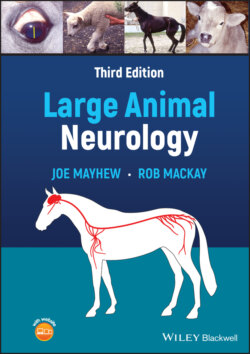Читать книгу Large Animal Neurology - Joe Mayhew - Страница 122
Оглавление16 Dilated esophagus
Dilated esophagus can be due to obstruction or primary dysfunction of the esophagus. Permanent dilation of the esophagus or megesophagus is not frequently seen in large animals. However, it has been observed with chronic intra‐ and extraluminal esophageal obstruction caused by lower esophageal sphincter scarring and ulceration, persistent right aortic arch, severe pneumonia with dyspnea and with gastroesophageal ulceration, and associated bruxism, retching and aerophagia. Such causes are far more common than primary neuromuscular esophageal dysfunction that does however occur in the proximal esophagus as a complication of laryngeal surgery.1
Regional aganglionosis and deficiency of neural elements have been purported to be congenital neural causes of megaesophagus.2 Also, some young foals showing nasal regurgitation of milk may have primary esophageal muscular lesions seen at postmortem examination; however, others diagnosed as having neonatal encephalopathy do well with supportive care so euthanasia should not be embarked upon too quickly.3–5
Figure 16.1 Dilation of the esophagus with regurgitation in large animals is most frequently due to upper gastrointestinal obstruction or due to functional disorders such as equine dysautonomia and ruminant vagal indigestion. Megaesophagus can accompany botulism, but otherwise it is only rarely seen without an esophageal stricture. These two cases demonstrated with contrast esophagram (A and B) had acquired, mild, generalized, fluctuant, somatic weakness and poor esophageal function of several months duration for which there was no definitive pathologic lesion determined.
A dilated esophagus is seen in several diffuse myasthenic syndromes, many of which defy specific diagnosis (Figure 16.1), and some degree of paresis and dilation of the esophagus is one of the hallmarks of the paralytic gastrointestinal syndrome in horses from Europe and from Patagonia, known as grass sickness and Mal Seco, respectively.
A familial form of megaesophagus particularly involving the thoracic esophagus occurs in Friesian horses in Europe which is associated with increased deposition of disorganized collagen mainly in the nondilated portion of the esophagus and a decrease in neural elements.6,7
Several drugs influence esophageal motility, and certainly the α‐2 agonist sedatives will result in air detectable in the esophagus radiographically. Also, isoproterenol, terbutaline, and oxytocin reduce the contractility of esophageal smooth muscle of horses.8
Consideration may be given to other infrequent causes of signs of regurgitation and suspected esophageal paralysis including neuroborreliosis, polyneuropathies, polymyopathies, and myasthenia gravis.9 Finally, local brainstem encephalitis in horses can result in persistent esophageal dilation and obstruction.10
References
1 1 Barakzai SZ, Dixon PM, Hawkes CS, Cox A and Barnett TP. Upper esophageal incompetence in five horses after prosthetic laryngoplasty. Vet Surg 2015; 44(2): 150–155.
2 2 Broekman LEM and Kuiper D. Megaesophagus in the horse. A short review of the literature and 18 own cases. Vet Q 2002; 24(4): 199–202.
3 3 Mullen KR, Rivera BN, Tidwell LG, et al. Environmental surveillance and adverse neonatal health outcomes in foals born near unconventional natural gas development activity. Sci Total Environ 2020; 731: 138497.
4 4 Giguère S, Weber EJ and Sanchez LC. Factors associated with outcome and gradual improvement in survival over time in 1065 equine neonates admitted to an intensive care unit. Equine Vet J 2017; 49(1): 45–50.
5 5 Toribio RE. Equine Neonatal encephalopathy: facts, evidence, and opinions. Vet Clin North Am Equine Pract 2019; 35(2): 363–378.
6 6 Komine M, Langohr IM and Kiupel M. Megaesophagus in Friesian horses associated with muscular hypertrophy of the caudal esophagus. Vet Pathol 2014; 51(5): 979–985.
7 7 Ploeg M, Grone A, Saey V, et al. Esophageal dysfunction in friesian horses: morphological features. Vet Pathol 2015; 52(6): 1142–1147.
8 8 Wooldridge AA, Eades SC, Hosgood GL and Moore RM. in vitro effects of oxytocin, acepromazine, detomidine, xylazine, butorphanol, terbutaline, isoproterenol, and dantrolene on smooth and skeletal muscles of the equine esophagus. Am J Vet Res 2002; 63(12): 1732–1737.
9 9 Johnstone LK, Engiles JB, Aceto H, et al. Retrospective evaluation of horses diagnosed with neuroborreliosis on postmortem examination: 16 cases (2004–2015). J Vet Intern Med 2016; 30(4): 1305–1312.
10 10 Green EM, Roth JE and McClure RC. Recurrent esophageal obstruction in the horse: neurologic considerations. 32nd Ann Conf Am Assoc Equine Pract 1986.
